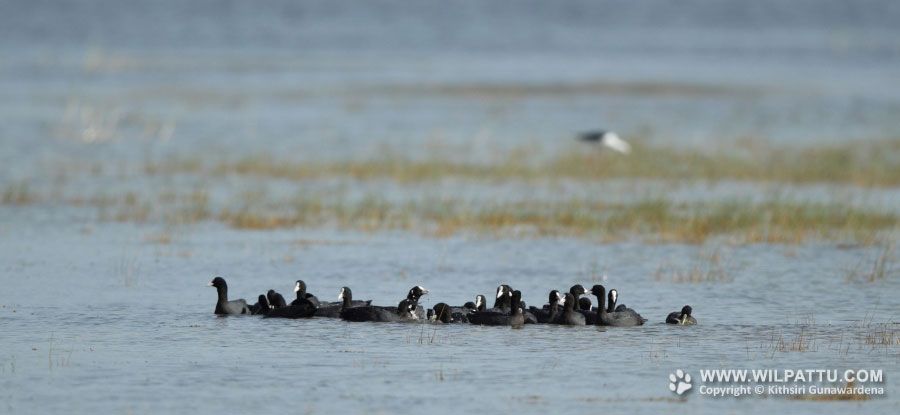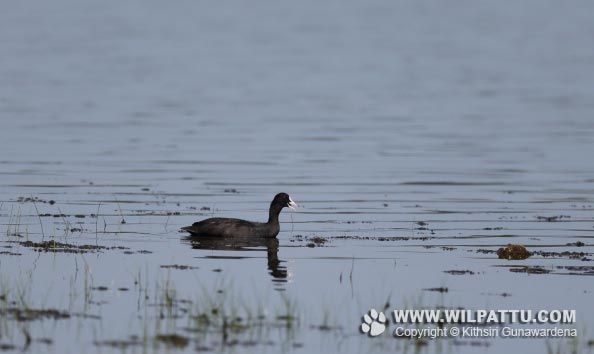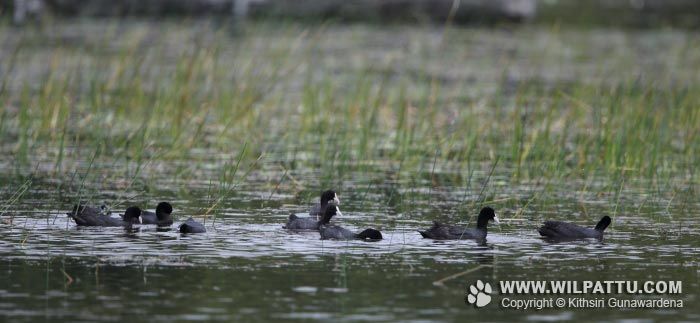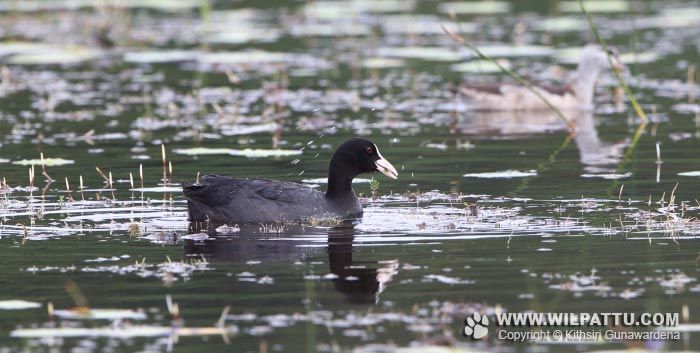
Birds ‹‹ Go Back
This is a breeding resident in the northern lowland areas. It is a regular migrant as well and during some years, large numbers can be seen in the dry zone. Occasionally few individuals find their way in to the wet zone as well. This is a widespread species found in Europe, Asia, Australia, New Zealand and Africa.
The conservation status of the species under reference is regarded as Least Concerned (National Red List 2012).
The Common Coot is a species strictly protected under schedule IV of the Fauna and Flora Protection Ordinance as amended by Act No. 22 of 2009.
My first sighting of this species was on the 29th of June 2006 at the Olupattawa Lake in Kottawa, which happened to be the first ever record of this species from the wet zone. Since then I have observed this species at many localities in the North including Kayts in Jaffna, Mannar, Giant’s Tank in Murunkan, the Nawadankulama Tank, Anuradhapura and Anawilundawa. In October 2002 one bird was seen throughout the month at a small water body at Kotte along the Japan Friendship road. In October 2002 and November 2008 I counted flocks of 240 and 204 birds respectively at Nawadankulama. In November 2011 a few birds were seen at Bundala National Park.
On February 6th 2004 I counted 18 birds in a small tank in the middle of a large field of paddy in the Jaffna peninsula. One pair had two immature with them.They were both black in colour and their shields were not developed. Another bird was seen in another part of the same water body with 5 very small immature. They had reddish beaks and yellow-orange down on their head and neck. The rest of their bodies were covered with black down feathers. As I watched, the adult continuously pecked on the head of one singled out immature and chased it away. These birds are known to attack one or two of their own chicks and sometimes kill them when food is scarce.
On the 26th of March 2010 while studying birds in the Mannar area I came across a nest of this species at the Vankalai Tank. One bird was sitting on the nest, which was built primarily with the stems of Lesser Bulrushes Typha angustifolia and was about 40 feet from the lake´s shore. It was a mound of vegetation raised about 6 inches or so from the water. While one bird was sitting, its mate was busy bringing long strands of reeds and other vegetable matter to the nest. The bird in the nest accepted what its mate brought and inserted them into the nest. The beak and the shield of the sitting bird had a pink wash as opposed to the usual ivory white. Also in another part of the tank, I observed a pair of this species with 10 tiny chicks. They had bare reddish heads with their necks covered in orange down feathers. Their beaks were red with the tips very prominently white. The rest of the body was black. The parents were busy feeding them with vegetable matter and insects caught among the reeds. Here again I observed the parents viciously pecking at an individual chick which kept on begging for food, while feeding only the others.
I observed this species in Wilpattu for the first time in September 2011 at Panikkar Villu. In 2012 these birds were observed at Panikkar Villu, Borupan Wila, Thimbiri Wila and Kokkare Villu from February to October. They were not seen during 2013. On the 19th of August 2012 I observed an interesting behaviour of these species at Kokkare Villu. There were about 22 birds of this species scattered close to one locality at Kokkare Villu. As we watched, a subadult White-bellied Sea Eagle swooped down but did not succeed in catching a bird. Instantly all the birds flew close to each other and each time the eagle flew down, this compact group moved away while splashing the water with their wings creating much turmoil. This display was quite effective and after a few attempts the eagle gave up on the attack and flew off.




